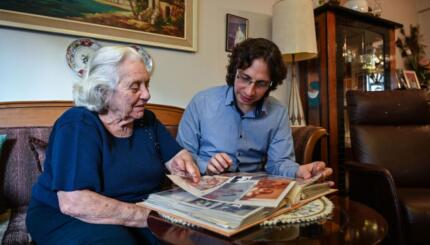Reprinted with permission from Over the Top Judaism: Precedents and Trends in the Depiction of Jewish Beliefs and Observances in Film and Television (University Press of America).
For more than a quarter of a century, a lot of movies and TV programs have been obsessed with Judaism. One can argue that many American Jews were infatuated first with film and then, simultaneously, with television. The movies, and then television, have imposed standards, aesthetics, values, and even vocabulary that American culture, including American Jewish culture, had to engage, whether in imitation, protest, or adaptation. Yet such engagement, for all of its occasional valor, has not been without distortion of Judaism, of Jewish teachings and observances.
The Goldbergs Become Molly
At first these seductive media mesmerized Jews. But Judaism was left alone. It was kept offstage, to the side, as a precious relic or heirloom. One thinks of the 1950 film, Molly, originally entitled The Goldbergs, and based on the famous television series of that name.
 Gertrude Berg assumed her classic TV role as Molly Goldberg, beloved Jewish matriarch. Most of the film came across as a rather general nostalgia for European parents, not much different from the I Remember Mama genre. Toward the end one sees covered challah rolls and Shabbat candles, though the actual rituals are only suggested and not performed.
Gertrude Berg assumed her classic TV role as Molly Goldberg, beloved Jewish matriarch. Most of the film came across as a rather general nostalgia for European parents, not much different from the I Remember Mama genre. Toward the end one sees covered challah rolls and Shabbat candles, though the actual rituals are only suggested and not performed.
With your help, My Jewish Learning can provide endless opportunities for learning, connection and discovery.
It was a bold statement in the 1950s just to show challahand Shabbat candles at a time when the name of the film had to be changed from The Goldbergs to Molly. For most of the Jewish audience, the immigrant experience and the close-knit family were still realities, and there was no need to translate or to fill in between the lines. Likewise, the presence of ritual objects in the homes of parents was still widely taken for granted. (By the 1970s, ritual objects in film and TV began to be more the domain of immigrant grandparents.) Just the image of a Sabbath table spoke volumes more than any dialogue.
In the 1960s and 1970s, however, depiction of Jews and of Jewish practices became more aggressive, more pointed. There was a determined and concerted effort to stand up for Jewish identity and to throw Jewish practices back into the face of a film culture that had ignored them or shunted them aside. The irony was that the “film culture” consisted of many Jews who had been embarrassed about delving into their heritage, but now sanctioned, with a vengeance, an explosion of Jewish references, associations, and even ambivalences.
The Way We Were
All of this came to a head in the 1973 film, The Way We Were, starring Barbra Streisand and directed by Sidney Pollack. The well-known singer-actress was taking her stand that ethnic women with a not-so-typically-Hollywood screen look, in this case Jewish women, can successfully chase after matinee-idol Gentile men.
Whatever one thinks of Streisand’s “cause,” it should be noted that The Way We Were was one of the first portents that Judaism would not go untouched or unscathed in the process of the new Jewish self-determination, even self-infatuation, in flimmaking. In one scene in The Way We Were, Streisand’s character presents her Gentile lover (played by Robert Redford) with a typewriter and calls it a “Rosh Hashanah present.” One can imagine Gentile viewers wondering at the time whether Rosh Hashanah, the Jewish New Year, was a time when they should be sending gifts to Jewish friends.
One can safely assume that at the time, Jewish viewers were savvy enough to realize that Streisand and Company were inventing this gift as an inside joke to make the point that the public ought to realize that Jews have holidays other than Hanukkah. This was their way of “opening up” Judaism. Little did they know that they were starting a trend that would become widespread and shameless–namely, the concoction, or, more often, the corruption, of Jewish customs and observances under the rubric of “creative media writing.”…
Paradoxically, such retreading of Judaism, even when misleading, represented the height of comfort with Judaism in the general culture, on the part of both Jewish and non-Jewish writers and producers. It also revealed an antipathy on their part toward religious Jews that rivaled and even exceeded early Hollywood denigration of Jews as ridiculous or embarrassing.
The acceptance, in the 1980s, of Judaism as a prominent theme in television and in the movies did not come without baggage or cost. The new emphasis on “interpreting” Jewish ritual practices provoked both caricature or censure of Judaism.
Shabbat
Pronounced: shuh-BAHT or shah-BAHT, Origin: Hebrew, the Sabbath, from sundown Friday to sundown Saturday.


